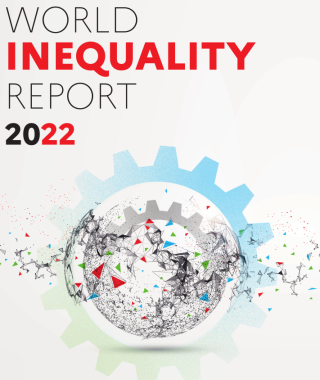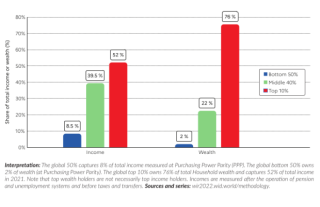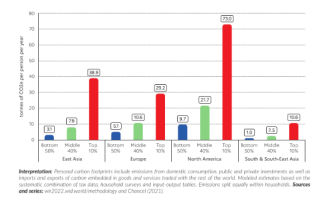World Inequality Report 2022

The World Inequality Report 2022, released in December 2021 gives up to date insights into income and wealth distribution across the world. The report gathers together in one place data from all continents collected over a four year period.
The findings are that income and wealth inequalities are large with the richest 10 per cent of the global population receiving 52 per cent of global income and 76 per cent of all wealth leaving the poorest half of the population with just 8.5 per cent of global income and less than 2 per cent of all wealth (Figure 1).
Figure 1 : Global income and wealth inequality, 2021

Across the world then, Europe has the lowest levels of inequality with the top 10 per cent receiving 36 per cent of the income share and the Middle East and North Africa (MENA) is the least equal with the top 10 per cent there in receipt of 58 per cent of all income.
The report notes that both wealth and income inequalities have been increasing, albeit at different levels, almost worldwide since the 1980s and find that “inequality is not inevitable, it is a political choice.” [1] Inequality between countries has declined but inequalities within countries has increased with the gap between the average incomes of the top 10 per cent and the bottom 50 per cent almost doubling from 8.5 times to 15 times. The report notes that “This sharp rise in within country inequalities has meant that despite economic catch-up and strong growth in the emerging countries, the world remains particularly unequal today. It also means that inequalities within countries are now even greater than the significant inequalities observed between countries.”[2]
Another notable from the Report is that wealth has been transferred from the public sphere to the private, as countries get richer, governments have become poorer. As
“the share of wealth held by public actors is close to zero or negative in rich countries, meaning that the totality of wealth is in private hands. This trend has been magnified by the Covid crisis, during which governments borrowed the equivalent of 10-20% of GDP, essentially from the private sector. The currently low wealth of governments has important implications for state capacities to tackle inequality in the future, as well as the key challenges of the 21st century such as climate change.”[3]
Gender
Gender inequality still remains a major issue worldwide. This Report sets out the first estimates of the gender inequality in global earnings. In 1990, women’s share of total income from work was close to 30 per cent and is still less than 35 per cent currently. Gender equality would suggest that women should be earning closer to 50 per cent of all income from work. So whilst some progress has been made, it is slow and spread unevenly across the world with some women experiencing a reduction in income share.
Climate Action
Income and wealth inequalities are closely linked to climate change inequalities. The average emission person emits “6.6 tonnes of carbon dioxide equivalent (CO2) per capita, per year.” However, the top 10 per cent of emitters produce almost 50 per cent of all emissions as opposed to the 12 per cent emissions created by the bottom 50 per cent. Figure 2 shows that the split isn’t as simple as high income country versus low income country with high emitters in low income countries and low emitters in high income territories.
A just transition demands that climate action policies target heavy wealthy emitters, who can afford alternatives and ensure that carbon taxes do not disproportionately impact those who currently create lower emissions but can can least afford them.
Figure 2 : Per capita emissions across the world, 2019

The Report notes that dealing with the myriad challenges posed by the 21st century so far and into the future will require income redistribution and investment in education, health and infrastructure, that recent developments “ in international taxation show that progress towards fairer economic policies is indeed possible at the global level as well as within countries…...Inequality is always political choice and learning from policies implemented in other countries or at other points of time is critical to design fairer development pathways.[4]
Ireland
Income
Whilst the World Inequality Report 2022 does not look specifically at Ireland, recent research from NERI, based on Eurostat figures finds that “inequality in Irish wages between the bottom (the 10th percentile) and the top (the 90th percentile) is higher than in any other high-income European country by some margin.” [5] The purpose of economic development should be to improve the living standards of all the population, not just those at the top. Earning a living wage is vital if households are to enjoy a decent standard of living.
Wealth
Taxes on wealth are minimal in Ireland. Revenue is negligible from capital acquisitions tax (CAT) because it has a very high threshold in respect of bequests and gifts within families and the rates of tax on transfers of family farms and firms are very generous. Data from the CSO points to both inheritance and value of property as being key components of wealth. The findings of this survey should inform taxation policy in terms of how wealth and assets are treated by the taxation system and when considering options such as a Site Value Tax and any changes to capital acquisitions tax and capital gains tax.
A New Social Contract
As part of a new Social Contract, Social Justice Ireland urges Government to ensure that tax and welfare systems are fit for purpose. Good Governance is a key pillar of a New Social Contract and requires a broadening of the tax base alongside an increase in the overall tax take.
- We need to move towards increasing the total tax-take so that sufficient revenue is collected to provide redistribution and public services at average European Level
- We need to continue to increase the minimum effective tax rates on very high earners so that rates are consistent with the levels faced by PAYE workers.
- We should restore the 80 per cent windfall tax on the profits generated from all land re-zonings.
- We must make tax credits refundable to address the working poor issue.
- We must develop policies that allow taxation on wealth to be increased.
- We must poverty proof all budget tax packages to ensure that tax changes do not further widen the gap between those with low income and the better off.
[1] https://wir2022.wid.world/
[2] Ibid
[3] Ibid
[4] Ibid
[5] https://www.nerinstitute.net/blog/wages-ireland-are-more-unequally-dist…